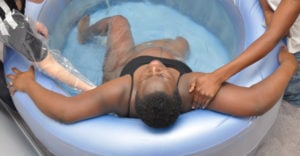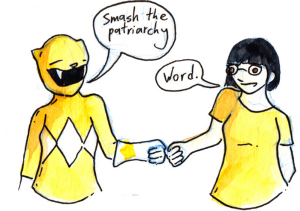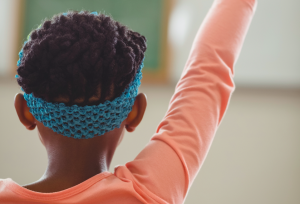
A student smiles into the camera in a classroom full of their peers.
Many people – from politicians to journalists to folks with privilege – argue that education is the great socioeconomic equalizer. Going to school will provide everyone with the professional opportunities necessary to overcome and eliminate oppression, they say.
But education is not the great equalizer.
This narrative is a myth. It maintains that the education system is equal for everyone. It isn’t.
It denies that we have to implement broader structural changes in order to achieve social justice. We do.
And it victim blames.
Reproducing a faulty “pull yourself up by your bootstraps” mentality, it suggests that if someone struggles in adulthood, it must be their fault for not taking their education seriously. Their struggles could never be the result of oppressive social, political, and economic structures!
Here’s the truth, though: Educational resources remain unequally distributed, more available to wealthy, white, able-bodied, cisgender, male students. Meanwhile, people from low-income backgrounds, People of Color, women, people with disabilities, and LGBTQIA+ people continue to struggle to access the same tools for academic and professional advancement.
Even worse, schools – K-12 and higher education – are often incubators where students, teachers, administrators, and staff reinforce oppressive ideas and practices. Rather than a place of safety and inclusion, most schools reinforce hostility towards students from historically marginalized communities.
Such practices cause these students to feel vulnerable, alienated, and disengaged in school. And this negatively affects their scholarly achievement.
These systematic exclusions prevent the institution of education from being the great equalizer that so many claim it to be.
Here are twenty intersectional examples why.
1. Students of Color Are Disciplined More Than Their White Counterparts
Due to ongoing racist ideas that characterize People of Color as inefficient, aggressive, and/or unintelligent, school administrators, teachers, and staff are more likely to label non-white students as “troublesome.”
Consequently, even when engaging in the same behaviors as their white counterparts, students of Color are punished at higher rates. Given that such punishment often includes in- and out-of-school suspensions, this means less time learning in the classroom and, by extension, lower grades.
Such punishments are also recorded on academic records, negatively influencing future academic and professional advancement.
2. English-Only Policies
For the most part, English is the primary language of instruction throughout the US. As a result, non-English speaking students often struggle to succeed academically, particularly because dual language, bilingual, and English as a Secondary Language (ESL) instruction remain limited and under-resourced.
Accordingly, neither non-English speaking students nor their guardians are able to navigate the complicated educational landscape – or take advantage of some of its opportunities – like their English speaking peers.
Furthermore, immigrant and Native American students are regularly punished in school for speaking languages other than English.
3. Low-Income Students Must Work After School and During the Weekends
Students from low-income households are often required to work outside of school hours in order to help their families financially. Sometimes starting while in elementary school, this could include looking after younger siblings or elderly relatives while their parents work second or third jobs. Later, this could also include employment outside of their chosen career path.
Therefore, low-income students often get less sleep and have less time to complete homework. They also have less time and resources to access extra curricular activities and unpaid internships that would otherwise help to develop socially, academically, and professionally.
4. Tracking
School districts regularly recognize only narrow, “normative” expressions of intelligence and ability. Once defined “good” and “smart,” students are often placed into honors courses. And they tend to stay there.
Conversely, once defined “bad” or “unintelligent,” students are placed into remedial courses. And they tend to stay there, too.
Tracking typically occurs very early during a child’s academic career. Thus, those with the resources and privilege to access strong pre-school and early-elementary education are often shepherded into these advanced programs.
Unfortunately, because the gap between tracks widens each subsequent school year, even when non-honors students excel, it’s often too difficult to make the jump to the advanced level.
Moreover, beginner and low-achieving teachers tend to be placed in struggling classrooms. Students with the greatest need for high achieving teachers, therefore, often cannot access the resources and instruction necessary to close the achievement gap.
5. Whitewashed Curricula
History, social studies, and literature curricula in the US primarily emphasize and celebrate white, cisgender, male achievements. They don’t highlight the histories of People of Color, women, sexual minorities, and so on. And they increasingly attempt to ignore structural oppression.
Cases in point: The ongoing celebration of Columbus Day in schools nationwide. Minimizing the trans-Atlantic slave trade by referring to enslaved Africans as “immigrant workers.” Outlawing Ethnic Studies and prejudicially misrepresenting Latinxs. Limiting English literature courses primarily to works written in North America and Great Britain, while ignoring writers from places like the Caribbean and Africa.
Students of Color subsequently tend to feel alienated from the learning process. And there is little opportunity to decenter the narrow perspectives cultivated among those from privileged backgrounds.
6. Teachers Who Don’t Look Like Their Students
Too often, white teachers – frequently without substantial experience navigating the complexities of racial allyship – are placed in classrooms mainly of students of Color. Homophobic and transphobic hiring policies and teaching environments limit LGBTQIA+ people from becoming teachers. Gendered prejudices encourage women to become elementary school teachers, but not higher educators. The same prejudices encourage men to become higher educators, but not elementary school teachers.
Also, administrators and district offices that design curricula and make hirings/firings mainly employ white, cisgender, heterosexual men.
As a result, most students don’t encounter teachers that would more personally resonate with them. This pattern also limits the ideas and experiences students are exposed to, and the professional possibilities they might consider.
7. Lack of Access to Advanced Placement, Vocational, and Special Education
Not every district has equivalent resources in order to provide adequate (let alone excellent) advanced placement, vocational, or special education. Therefore, only some students – due to nothing more than the financial circumstances of their guardians – gain access to programs designed to set them up for future professional success.
This is particularly problematic within the context of special education, which every student legally should be able to obtain when necessary.
8. Uneven Access to Technology
Technology has become a fundamental component of the learning process. Teachers increasingly employ innovative online resources in the classroom, and students use computers for research and homework.
However, not all students attend schools that can fully incorporate technology. Further, due to financial constraints and library closings nationwide, there remain children without access to computers and the Internet outside of the classroom.
Nonetheless, all students are expected to achieve computer mastery in order to progress to secondary/higher education or to get most jobs.
9. Standardized Testing
Passing a standardized test remains one of the primary mechanisms through which students advance from grade to grade. However, these tests only measure a narrow segment of a person’s abilities and knowledge.
Firstly, testing is a high-pressure situation. Often, the results measure one’s ability to take a test more than their actual knowledge.
Secondly, most students now take standardized tests on computers, a medium for which many are not proficient.
Thirdly, the material contained within standardized tests remains narrow and inaccessible to numerous test-takers.
Fourthly, standardized tests reward only particular types of intelligence, thereby neglecting other areas where many students excel.
10. Too Few School Psychologists and Counselors – But Plenty of In-School Police Officers
Because of a shortage of school psychologists and counselors (or the lack of funds to hire them), there are limited resources for emotional and mental health. In response, emphasizing punishment and discipline over reconciliation and inclusion, many districts have added more and more police officers.
Additionally, unless a student comes from a privileged background, they might not be aware of or have access to the necessary resources to pursue a particular vocation, apply for college, or find scholarships – endeavors a counselor might be able to assist with.
11. Structural and Infrastructural Inaccessibility for Students with Disabilities
Schools legally must be accessible. However, many remain partially inaccessible to students with disabilities. There are many examples of accessible entrances, but there are still classrooms, libraries, laboratories, theaters, or even entire floors cannot be reached by all students.
Furthermore, schools often reproduce ableist attitudes and practices. Many able-bodied teachers and students still consider service animals, sign language (interpreters), and other assistive learning devices or strategies as “distracting.”
This, therefore, limits the degree to which students with different abilities can access equivalent instruction/resources.
12. Transphobic Policies
Most districts reinforce cisgender policies. For example, in most schools, one must use the bathroom that corresponds to the sex assigned at birth. Similar rules apply regarding school uniforms and enrollment in non-coed clubs, sports, and so on.
Consequently, many schools cultivate a hostile environment for transgender and gender non-conforming students.
13. Ongoing ‘Boys Will Be Boys’ Mentality
Schools regularly reproduce toxic masculinity and render classrooms dangerous for female students. In fact, many teachers and coaches actively teach sexism, homophobia, and fatphobia to male student athletes in particular.
However, teachers often (must) punish female and LGBTQIA+ students for physically defending themselves from bullying behavior, thereby teaching boys that their behavior is acceptable, if not expected.
Furthermore, universities systematically defend fraternities and student rapists, all while silencing the predominantly female students who have been assaulted.
14. Lack of Structural Support for LGBTQIA+ Students
Privileging heterosexual, cisgender experiences and identities, most districts don’t equip themselves to provide sufficient support for LGBTQIA+ students.
Few teachers are offered training geared towards empathizing with LGBTQIA+ students, or with addressing their specific needs. At the same time, few schools provide material for students questioning their sexuality or gender identity, or for students striving towards allyship.
15. Favoring Male Athletics
Many schools pool resources into boys’ football and basketball teams, as well as other boys’ sports. However, girls’ teams often struggle to get adequate funding, the best coaches, or school/community support.
Meanwhile, districts continue to defund arts programs. Thus, only narrow extracurricular activities – which themselves often reproduce toxic masculinity – receive adequate investment. This limits many students’ abilities to pursue their non-academic interests.
It also fails to decenter problematic notions that suggest that male athletics are more exciting and valuable than female athletics or non-athletic activities.
16. Uneven, Narrow, Biologically Inaccurate Sex Education
Sex education differs from district to district. Many schools offer little to no sex education. And, among those that do, many emphasize a Christian-centric, exclusionary model.
Many schools lose funding for providing anything beyond abstinence-only sex education, which has been proven ineffective. Most schools also reinforce cisgender and heterosexual identities and experiences, failing to address the questions and concerns of LGBTQIA+ students.
Meanwhile, many sex ed teachers – who are often themselves ill-prepared to teach such a complex subject – often demonize abortion and neglect teaching active consent.
Consequently, in many schools, students must navigate their social worlds without obtaining adequate knowledge about their bodies, identities, or sexual health options, and without challenging dangerous notions concerning male sexual entitlement.
17. Under-Resourced Community Colleges
A pervasive narrative throughout the US argues that low-income and lower-achieving students can use community college as a stepping stone towards a four-year degree.
However, community colleges are often too expensive, credits do not always transfer, and the mechanisms to transition to a four-year institution remain inconsistent.
Also, community colleges vary in quality. Though, due to financial constraints, students often have limited options regarding which one to pursue.
Therefore, community college is not always a failsafe option. Particularly in poor rural and urban settings, statistically few community college students move on to and graduate from four-year programs.
18. Students From Struggling High Schools Are Often Unprepared for Four-Year Programs
Even high-achieving students from under-resourced high schools are often unprepared for the rigors of a four-year program. Especially in elite universities, those from low-income and historically marginalized backgrounds are often made to feel alienated from both their peers and the institution itself.
However, there are few programs in place to help such students to succeed, to transition into an otherwise unfamiliar environment. Consequently, many drop out.
19. Legacies
One is more likely to gain admittance to a university if a family member previously graduated from there. However, given the history of racial exclusions relating to higher education, not to mention the expenses, most family members are likely privileged themselves.
As a result, this cycle of privilege continues, particularly as new legacies – who themselves might not be incredibly high-achieving – are enrolled over more deserving students.
20. Debt
College is expensive! With tuition and room and board costing from $11,000-$60,000 per year, no longer can students pay for higher education on their own. And few families can afford these costs either.
So, students from non-wealthy families – in order to earn the degree that might one day allow them to get a full-time, well-paying, secure job (which are becoming rarer and rarer) – must take out tens of thousands of dollars in debt in order to do so.
This limits access to unpaid internships and other professional opportunities during college and post-graduation. Indeed, college debt continues to follow and restrict one’s personal and professional opportunities for decades, which in turn limits the degree to which they can start a family, for example, or save up for their children’s astronomical tuition costs.
***
“Education is the great equalizer” is a boldface lie.
Not only do various intersecting forces prevent all schools from receiving equivalent funding. But classrooms themselves also remain places of oppression and exclusion.
We must stop the victim blaming that deflects attention from actual structures that need fundamental, long-term reform.
[do_widget id=’text-101′]
Andrew Hernández is a Contributing Writer for Everyday Feminism. He is a public anthropologist and teacher, completing his PhD in cultural anthropology at the Graduate Center, City University of New York. Andrew bases his research out of West Africa and the Sahara, working on issues of human rights, crisis and religion. A former adjunct lecturer, he is now a Professional Teaching Fellow at the University of Auckland in New Zealand. You can follow him on Twitter @AndrewHernann or at his website www.AndrewHernann.com.
Search our 3000+ articles!
Read our articles about:
Our online racial justice training
Used by hundreds of universities, non-profits, and businesses.
Click to learn more




















